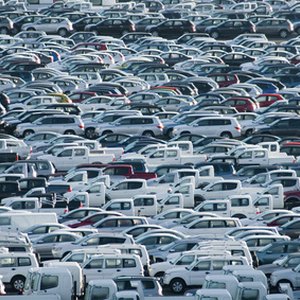
Automobiles are categorized into classifications for insurance purposes, and one of the primary classifications is commercial auto. Within commercial auto insurance, vehicles are further classified by weight or vehicle type, but each insurance company is allowed to set its own classification standards as long as they meet state law. When applying for coverage on the widely-accepted ACORD application forms, you must choose from a list of standardized classifications that dictate how the insurance you are applying for will cover the vehicles in your fleet. These classifications are the same regardless of which state's ACORD form you use and become part of the policy once it is issued.
1-Any Auto
Covered auto symbol "1" means that the insurance on the application will apply to any auto, meaning literally any vehicle in use by the business regardless of ownership. This is the broadest classification of coverage and is not widely used. Insurance companies may only use symbol 1 for liability insurance.
2-All Owned Autos
Covered auto symbol "2" means that the insurance on the application will apply to all owned autos, or any vehicle owned by the business. This can be helpful for businesses with large fleets that gain and lose vehicles frequently. Insurance companies may use symbol 2 for liability, medical payments, uninsured motorist and physical damage coverages such as comprehensive and collision.
3-Owned Private Passenger Autos
Covered auto symbol "3" refers to all "owned private passenger autos," which is a limited selection of symbol 2. Businesses with fleets that encompass vehicles of different sizes and types may wish for private passenger autos to be insured differently than larger trucks, so coverage can be limited to the smaller vehicles by using symbol 3 on the application. Symbol 3 can be applied to the same categories of coverage as symbol 2, plus towing and labor coverage.
4-Owned Autos Other Than Private Passenger
Covered auto symbol "4" refers to the opposite subset of symbol 3, "owned autos other than private passenger." This would include all vehicles owned by a business except those that qualify as private passenger, such as box vans or dump trucks. Towing and labor coverage is not eligible for symbol 4 vehicles because these vehicles tend to need specialized roadside assistance.
5-All Owned Autos Which Require No Fault Coverage
Covered auto symbol "5" is very specific and does not apply except in no-fault insurance states. "All owned autos which require no fault coverage," or symbol 5, can only be applied to no-fault coverage, often called "personal injury protection" (PIP) by the states that use it.
6-Owned Autos Subject To Compulsory UM Law
Covered auto symbol "6" refers to uninsured motorist (UM) coverage. Certain states require vehicles to carry a minimum amount of UM coverage, so symbol 6 or "owned autos subject to compulsory UM law" would be used to attach UM coverage to vehicles in those states.
7-Autos Specified On Schedule
Covered auto symbol "7" is widely used in the insurance industry. It refers to "autos specified on schedule," meaning a list of vehicles submitted to the insurance company as part of the application. In cases like this, the commercial auto insurance policy would extend coverage only to vehicles specifically listed on the policy, and all additions to and deletions from the fleet must be reported to the insurance company so the policy can be modified.
8-Hired Autos
Occasionally a business must hire an automobile it does not own for business purposes, such as a taxi, delivery or catering service. Covered auto symbol "8" extends coverage to these "hired autos" for as long as they are hired by the business. Symbol 8 cannot be used for UM coverage.
9-Non-Owned Autos
Covered auto symbol "9" refers to "non-owned autos," such as employees' vehicles. When a business must insure these vehicles, it checks symbol 9 on the application. Symbol 9 can only be used for liability coverage.
References
Writer Bio
Stephen Hicks has been writing professionally since 2000. He recently published his first novel, "The Seventh Day of Christmas." He spent three years as a licensed life and property/casualty insurance agent in California. Hicks holds a Bachelor of Fine Arts in cinema studies from New York University.

